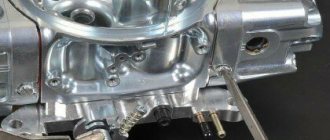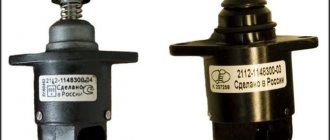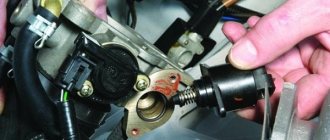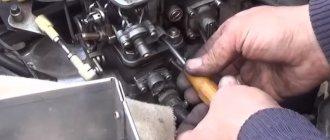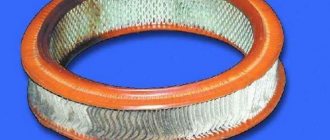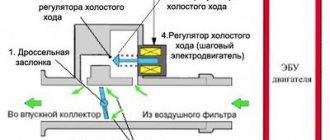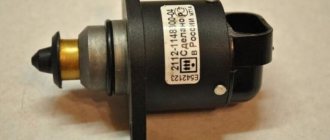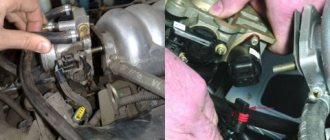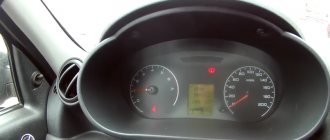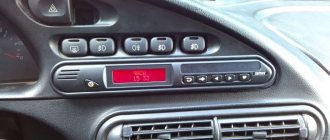Adjusting the XX on the injector
On cars equipped with injection engines, the fuel supply system is considered more reliable, but there are problems here too.
But they, as a rule, do not arise suddenly, progressing as the machine is used. The most common manifestations of malfunctions of this kind are delays in the response of the vehicle to a recessed accelerator pedal, jumping speed when operating in idle mode, loss of throttle response, increased fuel consumption, and the inability of the engine to operate normally in certain modes. The bad thing is that such symptoms are typical for a large number of malfunctions relating to a wide variety of car components, so the easiest way to localize the cause of unstable operation of the power unit is to carry out computer diagnostics, which can eliminate most of the malfunctions - from inoperability of ECM sensors to contamination of injectors, from improper formation of the fuel mixture before air leaks.
If the diagnostics do not reveal faulty components and assemblies, it makes sense to configure the XX.
So, we provide an approximate algorithm of actions that explains how to adjust the idle speed on an injection engine.
We start by checking the functionality of the idle speed sensor (which would be more correctly called a regulator). This device is a combination of a miniature stepper motor with an actuator in the form of a rod with a cone-shaped tip. IAC adjustment is carried out as follows:
- disconnect the positive terminal of the battery;
- dismantle the IAC (as a rule, it is attached to the motor housing with two screws);
- We thoroughly clean the sensor mounting hole using a compressor;
- We disassemble the IAC, which will allow us to assess the condition of the guide rod. It may be deformed or worn. In this case, it is easier to change the sensor itself than to bother with its repair;
- It is also necessary to check the cone needle - it should not have visible signs of damage. If there are defects, the regulator must also be replaced;
- using a multimeter, check that there is no damage to the coil winding of the XX sensor. It may be necessary to clean the contact group;
- We assemble the device and install it in its original place, start the engine and check its operation in all modes, including, of course, idle.
In other words, there is no need to manually adjust anything - the on-board computer independently makes all the necessary adjustments after each disconnection of the positive terminal of the battery (or disconnection of the supply voltage from the IAC).
However, quite often poor engine performance at idle is not the cause of failure of the regulator itself, but rather malfunctions in the functioning of the software. By the way, many parameters that affect the operation of the engine life support system can be adjusted by software. This is done through the use of a special device - an autoscanner. Knowing how the idle speed control installed on an injection power unit works, you can independently change some of its characteristics by first diagnosing the car with a scanner connected to the computer using a standard OBD connector.
If diagnostics show that everything is fine with the regulator, the reason may be software incompatibility with a specific IAC model. If replacing the latter with the correct option does not solve the problem, you will have to flash the BC. This procedure is called chip tuning among specialists. In theory, if such a procedure is performed by professionals, it should not only solve the problem of unstable engine operation at idle, but also adapt the operation of the ECU to a specific car owner. It is not recommended to reflash the on-board computer yourself - this can lead to many new problems, and it is far from certain that the old ones will be fixed.
Adjusting the injection engine and idling
On engines with a fuel injection system, as a rule, malfunctions do not appear immediately and tend to progress gradually. Typically, the driver notices that the car begins to respond to the gas pedal with delays, the speed jumps at idle, gasoline consumption increases, the engine loses power, the power unit may not operate smoothly in different modes, etc.
Various malfunctions can lead to such symptoms, so it is necessary to carry out computer diagnostics of the engine, check the ECM sensors, eliminate air leaks and general problems with mixture formation (lean and rich mixture), dirty injectors and other reasons. If no other deviations are detected, the injector needs to be adjusted. Let's start with adjusting the idle speed on an injection engine.
First of all, you need to start by checking the idle air control (IAC). This controller is a stepper motor with a special conical needle. The task of the IAC is to regulate the air supply under the control of the ECU to maintain idle speed. IAC malfunctions become a common cause of floating engine speed at idle.
To adjust the idle speed on the injector:
- disconnect the battery terminals and dismantle the idle air control;
- then the IAC mounting hole is cleaned using compressed air;
- Now you can disassemble the XX regulator, after which its guide bushing is checked. If the bushing is worn out, the element needs to be replaced;
- you also need to check the needle. No wear, damage or other defects are allowed. If deviations are detected, the IAC needle should be replaced;
- then, using a tester, the regulator windings are checked, and if necessary, the contacts are cleaned;
- At the end of the diagnostic and cleaning process, the device is put back, after which the engine operation at idle and other modes is assessed.
Let us add that a number of problems with idle speed can also arise after cleaning the throttle valve, which on many cars not only needs to be cleaned correctly, but also trained. If you don't know how to clean and adjust the throttle valve, we recommend reading about it in our separate article.
We also note that the injector adjustments and the operation of the power system can be influenced programmatically, that is, by connecting diagnostic equipment with special preinstalled programs to the ECM via the OBD connector. Once connected, you can evaluate many parameters of the operation of engine systems in real time, read, decipher and reset possible errors.
We also recommend reading the article about why high idle speeds occur. From this article you will learn the reasons for the increase in idle speed, as well as what methods can be used to eliminate this malfunction.
Carburetor engines
Single injection
In the case of carburetor-type engines, malfunctions may be associated with:
- violation of carburetor adjustments;
- air suction through hoses;
- wiring violation;
- malfunctions of XX valves;
- filter contamination;
- problems in the ignition system.
In the vast majority of cases, at higher speeds on carburetor engine versions, the cause should be sought in malfunctions and malfunctions of the metering device.
Chevrolet Camaro carburetor engine assembly
In case of increased idle speed, you will need to check the adjustment, make sure the integrity of the wiring and valve, and replace the old air filter if it is very dirty.
If we talk about how you can independently adjust broken or broken idle speeds, then the adjustment involves carrying out basic measures. You need to do the following:
- dismantle the carburetor unit, which is relatively simple;
- check the condition of all hoses and pipes;
- replace hoses and gaskets if necessary;
- change the clamps.
It is recommended to check the position of the valve in the first chamber of the carburetor engine. The thing is that sometimes this damper does not close completely. This is due to defects in the damper or incorrect adjustment of its drive.
Similarly, on carburetors the air damper does not always open completely. It should be checked and adjusted. And in case of defect or damage it will have to be replaced.
Carburetor contamination is considered a common cause of high idle speed. Therefore, owners of such machines must periodically clean the unit. Some do it on their own, others turn to specialists for help. The hoses are checked by pinching them while the engine is running.
When making adjustments, be sure to listen to how the motor operates. If after the next manipulation you hear that the speed begins to change, you have managed to find the source of the problems. That is, you pinched the hose that caused the revs to increase.
When gaskets tear and wear out, the clamps do not fit tightly enough into their seats, which leads to air entering the engine. Thus, the speed begins to increase.
When restoring all elements that could fail and lead to a violation of the idle speed, you should use quality and quantity adjusting screws. They allow you to return the speed to normal parameters.
Features of the adjustment procedure
The procedure consists of several successive steps. The main role here is played by 2 screws. This is a screw for adjusting the number of revolutions at idle, as well as an adjusting screw for the quality of the mixture at idle.
First, start your carburetor engine, warm it up to the required operating temperature, which is usually about 80 degrees Celsius. In this case, the carburetor valve must be in the fully open position. Tighten the quality screw all the way, then start turning it back about 2-2.5 turns. Turn the quantity screw literally 1.5 or 2 turns. Turn the quality screw in different directions to achieve maximum engine speed, leaving the current open position of the damper unchanged. Now grab the throttle stop screw, using it to set a stable but minimum speed. Repeat the procedure 3-4 times
It is important to find the most optimal position for the propellers so that the required quantity and quality of the fuel mixture is supplied for economical operation of the engine. The adjustment is checked by sharply opening and closing the throttle valve. If the motor operates normally and stably, you did everything right. In case of interruptions, you need to turn the quality screw all the way
Adjust the minimum speed using this screw in the same way as the previous quantity screw.
It happens that when the quality screw is rotated to the limit, the limiter plug breaks. If this happens, don't worry. You just need to purchase a new part and install it in place of the old plug.
Once you have completed the adjustment using the screws, you should be back to factory settings. Therefore, always rely on the manufacturer’s instructions, fulfilling all requirements and observing the idle speed parameters provided by the car plant. If this is not done, the operation of the motor will be disrupted and it may fail as a result.
How to adjust idle speed
Lada Priora sedan TAZ Logbook Selecting IAC for Priora
If the engine stalls at low speeds or under additional load in the form of the air conditioner or power steering on, then it is necessary to adjust the idle speed. Adjustment is also necessary when the engine idles rough.
In order to adjust the idle speed, you must perform the following steps:
1. Check the tightness of the automatic idle air control system. This is done if the engine runs normally when “cold”.
2. Before making adjustments, warm up the engine to about 80° C. If, on the contrary, the engine is hot and you have just arrived from somewhere, then you need to let the car cool down, and only after that do the adjustments.
3. Next, you will need to turn off the air conditioner, if, of course, there is one. If the transmission is automatic, then put it in position “P”. Connect the tachometer. The gas pedal should move freely.
4. Locate the idle air control lever. It should be located in the engine compartment at the end of the fuel supply cable. Turn the lever all the way to the right. Next, you need to look at the gap between the direction change lever and the locking ring; it should be 0.1 mm. Next, disconnect the connecting lever and check that the damper is not stuck.
5. When you return the power lever to its original position, make sure that there is a slight free play between the axle and the lever.
6. Next, remove the lever that connects the throttle switch directly to the direction change lever. Make sure that the idle speed adjustment bolt is pressed in. If it is not pressed, then the tension springs need to be replaced.
7. Check that the idle speed is within 700-800 rpm, adjust if necessary.
8. Next, put back the throttle lever; there should be no voltage.
9. Next, you need to measure the distance between the figured spring and the clamp, or between the installation locking clamp and the figured spring. To do this, turn the idle control lever all the way to the right. The measured distance should be one millimeter. Adjust the position of the figured spring if it has slipped out of place.
If your car has a Tetrota-1 control mechanism, then make sure that the flexible cable is not under tension. Therefore, it is necessary to move the switch lever all the way and only then begin adjustment, if necessary.
Disconnect the connecting lever that is located at the direction change lever in the high pressure pump.
Then you need to check the number of “idle” revolutions. If necessary, adjust. To do this, release the lock nut and set the required number of revolutions using the adjusting screw.
Use a spanner to adjust the speed of the high pressure pump. This way you won't damage the adjusting screw.
Then you need to install the connecting lever without tension.
Diagnostics and adjustment of the idle air regulator
Every modern car has a sensor responsible for the correct operation of the engine by adjusting the idle speed.
Unfortunately, without this small part, the engine will not be able to obtain the correct fuel-air mixture. This can lead not only to unstable engine operation, but also to premature failure.
When to worry
It is necessary to have an absolutely clear idea of what symptoms in the car’s operation should alert its owner:
— at idle speed the engine is not stable, it shakes, surges in terms of speed are absolutely clearly defined;
— while switching gears, the engine may simply stall. This fact is very dangerous, because it is not known where the car decides to stall: at an intersection or a railway crossing;
— after pressing the gas pedal, the speed does not increase;
— when automotive electrical appliances are turned on, engine speed decreases.
The above symptoms indicate the need to take urgent action.
What causes problems
If problems are identified, there is no need to delay! The reasons for unstable operation may be the following:
— problems with the guide needle (erased, deformed, jammed);
— a break or poor contact of the wires inside the sensor itself.
How to properly dismantle and install the sensor
Previously, in carburetor engines, the idle speed was adjusted using special screws. The process was quite complex and required good knowledge, and ideally, special equipment.
Nowadays, car repair has become much easier. Let's consider the sequence of actions when dismantling and installing the idle speed sensor:
— it is necessary to turn off the engine;
— disconnect the sensor connector;
— unscrew the screws and remove the damaged idle speed sensor;
— install a new sensor, performing the operations in reverse order;
— turn on the ignition, but do not start the engine. Power is needed for the electronic system to test the sensor and prepare it and itself to work together. This will only take ten to fifteen seconds;
— start the engine and check its speed.
Now the car can be used normally.
Here, perhaps, are all the main points regarding this device. Some craftsmen claim that the sensor can be repaired by injecting WD-40 liquid into it.
But personally, I would not recommend getting into the “soul” of the sensor. Still, this is a high-precision device. And after all kinds of injections, it can begin to work completely differently.
So what is this dubious saving? Here, as they say: “When trouble comes, open the gate!” Those. The sensor is broken, buy a new one and install it carefully yourself. So you will save money on car service. The rest is all imaginary manipulation with an unpredictable outcome.
Source
How to adjust idle speed on VAZ 2101-VAZ 2107
Communities UAZ drivers Blog Problem engine 4213 Mikas 7.2
Before proceeding with the adjustments, check out the photo below:
Note! Let's start with the fact that the photo above shows the screws through which the idle speed is adjusted. As you can see, the screws are located deep in the carburetor throttle body, so the screw under the number “1” is not visible in the photo. On some cars, bushings are pressed onto both of these screws, thanks to which the screws can only be turned half a turn. If these bushings make it impossible to turn the idle speed adjustment screw properly, then remove the screws and, as a result, break the bushing heads. When the screws are removed, brush off the remaining broken bushings and then screw the screws back into place!
Adjusting the idle speed using a gas analyzer:
1) First start the car and let it warm up to operating temperature of “90-95 ° C”. After the car has warmed up, use a screwdriver to start rotating the screw indicated in the photo under the number “2”, rotate this screw until the crankshaft speed reaches “750-800 min”.
Note! So that you understand in more detail, when tightening the screw, the crankshaft speed will gradually decrease, and with the opposite effect, that is, when it is loosened, the speed will gradually increase!
2) Now smoothly proceed to adjusting the “CO” content in the exhaust gases, to do this, rotate the screw indicated under the number “1” in the photo above. When tightening the screw number “1”, the “CO” content in the exhaust gases will gradually decrease, and when unscrewing it will correspondingly increase.
Note! It is necessary to regulate the CO content in exhaust gases in accordance with GOST for today. There is no need to lower the “CO” content below the norm, because in connection with this the content of unburned hydrocarbons “CH” may sharply increase. By the way, when adjusting screw “1”, it can change the crankshaft speed!
3) Finally, turn the screw under the number “2”, thereby bringing the crankshaft speed back to normal. After this, it is also recommended to use a device to check the “CO” content in the exhaust gases. If it becomes necessary to re-adjust both screws, adjust them until engine performance and CO emissions reach normal levels.
Note! After all the adjustments, sit in the car and sharply press and then release the gas pedal. Make sure that when you press the pedal, the engine runs smoothly, and when you release it, the car’s engine should not stall. If the engine stalls after releasing the gas pedal, then increase the crankshaft speed to “800 rpm”. The crankshaft rotation speed is adjusted with the screw number “2”!
Adjusting the idle speed without a gas analyzer:
1) To begin, slowly begin to rotate the mixture composition screw, which is indicated under the number “1”. Rotate it until the crankshaft speed is at its maximum. (The crankshaft rotation speed can be very easily determined by the tachometer readings)
Note! When this screw rotates, the release of harmful substances into the atmosphere is regulated. When turning this screw, the amount of CO emitted into the atmosphere will decrease, and when turning it away, on the contrary, it will increase!
2) Then use the screw under the number “2” to set the crankshaft speed to “1100 rpm”.
Note! The screw under the number “2” regulates the crankshaft rotation speed, therefore, when tightening this screw, the rotation speed will gradually decrease, and accordingly, when unscrewing it, it will gradually increase!
3) And finally, tightening the mixture screw (Number 1), ensure that the crankshaft rotation speed is “800 rpm”.
Additional video: Another way to adjust the idle speed, which you can see in the video below:
Note! Even if you watch the video, we advise you to still read the article because it goes into more detail!
https://vaz-russia.ru
Checking idle speed
When checking idle speed, proceed as follows:
The engine warms up until the thermometer needle is in the middle position. When adjusting the engine, the operating temperature must be maintained, the number of revolutions must be at least 1000 rpm. Afterwards, with the engine turned off, disconnect the plug of the throttle position sensor and start the engine.
Look at the tachometer, the engine should be running at 800 rpm. After that, increase the engine speed 2-3 times to 2000 rpm and take the idle speed readings. The speed should be about 850±50 rpm. In most cases, before checking and adjusting the idle speed, you must fulfill all the requirements given by the multi-position injection system.
The Ural motorcycle does not start at idle. carburetors for 301. I don’t know how to configure Topic author Zhanna
Stepan In the process of adjustment work, the following modes are checked and adjusted: engine operation at low idle speed synchronized operation of carburetors efficiency engine acceleration operation of the carburetor control drive Before starting the adjustment, it is necessary to check and adjust: the gap between the contacts of the spark plugs Anna the gap between the contacts of the breaker Katya the thermal value clearance in the gas distribution system. The adjustment is made on a warm engine separately for each carburetor. To adjust carburetors at low idle speeds, it is necessary to: set the shifter to the late ignition position Gregory, remove the cap from the spark plug of the right cylinder and, loosening the lock nut of the fitting, tighten the fitting, provide a gap of 2–3 mm between the tip of the cable and the fitting, releasing the lock nut securing the idle screw, screw it in so that the throttle is raised and the engine gives increased speed; screw in the quality control screw as far as it will go and reduce the engine speed as much as possible by unscrewing the idle speed screw; unscrewing the quality control screw; select a position in which the engine would run evenly and developed the highest number of revolutions. unscrewing the idle speed screw, reduce the number of revolutions to the minimum stable, after completing the adjustment, lock the screws using locknuts, lift the throttle of the adjustable carburetor by the cable, if at the same time the number of revolutions has increased, then the adjustment is considered complete, put the cap on the spark plug of the right cylinder, remove the cap from the spark plug of the left cylinder, adjust the right carburetor, repeating the sequence of Alina’s actions, check the synchronization of the carburetors at idle. Carburetors must provide the same number of engine revolutions when operating both the right and left cylinders. The correctness of the adjustment is checked as follows. With a running engine with adjusted carburetors, the cylinders are turned off one by one by removing the cap from the spark plug of either the right or left cylinder. The change in the number of revolutions when the engine is running on each cylinder is determined by ear. If the number of revolutions is different, then the carburetors are adjusted by screwing in or unscrewing the idle speed screws until the same number of revolutions is obtained. tighten the locknuts of the screws. adjust the synchronization of the cylinders. To do this: place the motorcycle on a stand, start the engine, engage 4th gear, turn off one of the cylinders by disconnecting the high voltage wire from the spark plug, increase the engine speed until the speedometer reads 50 km/h. After waiting a few seconds to make sure that the mode has stabilized, turn on the second cylinder and at the same time turn off the first by raising or lowering the throttle by rotating the fittings on the carburetor covers, achieve the same speedometer readings for both cases. Since the adjustment can continue for quite a long time, it is necessary to monitor the thermal conditions of the engine to prevent overheating. When the throttle valve is fully raised, the amount of fuel passing through the atomizer is not limited by the throttle needle, but depends only on the throughput of the main jet. If it is necessary to enrich the mixture, for example, when switching from summer to winter operation, carburetors are additionally regulated by a corresponding change in the position of the needle. The adjusting needle is connected to the throttle body using a lock. The needle has six annular grooves. By inserting the lock into one of the needle grooves, you can achieve six different carburetor adjustment positions. The lower the needle is, the poorer the mixture, and the higher it is, the richer it is.
Natalya Look here
Main problems and malfunctions of the carburetor.
Mesh filter. There are only two problems with this element:
To find out the cause of the failure, the fuel filter cap is unscrewed to remove the filter. If it's just accumulating dirt, a gasoline flush or blowing will help.
If there is visible damage to the strainer, a new one must be installed. In addition, there may be damage to the fuel connection (it is a repair practice to check this element).
Blowing out carburetor parts with compressed air is an acceptable and convenient repair practice.
Throttle body, carburetor fittings, intake or exhaust piping. All of the above parts are subject to depressurization. You can certainly check it in a primitive form. problematic site to smear with soap suds.
Adjusting and tuning the carburetor: main stages
Most modern gasoline cars are equipped with fuel injection systems, but before they gained dominance, all cars were equipped with carburetor systems. For this system to work correctly, the carburetor settings must be performed flawlessly. High-quality carburetor adjustment will reduce fuel consumption, make the engine run smoothly at idle, reduce the emission of harmful substances into the atmosphere and increase the overall engine life.
Most domestic cars have a carburetor system, and the question of how to adjust the carburetor will not lose its relevance for a long time. Many owners of rare old foreign cars also face the problem of how to adjust the carburetor. Since the principle of operation of carburetors around the world is no different, the algorithm of work will be the same.
The carburetor is the main component of the fuel system of any carburetor car. This is where air and fuel mix to form a fuel mixture that enters the engine's combustion chambers. A properly adjusted carburetor produces a fuel mixture in the required proportions. Such a mixture will not detonate in the cylinders, which will increase the life of your engine.
What to do if the idle speed fluctuates
Failures in the fuel supply system and incorrect settings of computer engine management systems are the most common problems in modern cars. Thousands of drivers appear at stations every day with such problems, but millions more operate cars with increased fuel consumption and other problems, without even realizing that their car has a serious breakdown.
The very first and most important indicator of such a problem is uneven speed. If your car has a floating idle speed, you can be sure that it consumes 15-20 percent more fuel than what is written in the passport. As soon as you notice such a problem, you should contact a professional service and fix all the problems.
The most common causes of floating speed in a car
Diesel engines rarely suffer from this problem. Floating speed in a diesel unit may indicate a breakdown of the injection pump system and other expensive and complex components. In carburetor gasoline power units, floating speed indicates poor carburetor tuning or breakdown of electronic idle speed sensors.
Most often this problem occurs in injection power units. And the most common causes of unstable speed in a gasoline injection engine are the following:
- clogging of the jets through which fuel enters the chamber;
- a problem with the “brains” of the car - the computer that controls all engine functions;
- breakdown of the air flow sensor and excessive enrichment of the mixture;
- failure of the spark plug or high-voltage wire;
- faulty electrical wiring of the engine, lack of power to the sensors.
The more expensive your car, the more technological mysteries it contains, which can cause floating speed. We consider the quiet and quiet operation of the power unit of a modern car to be an advantage. But sometimes, behind this silence and comfort, you can miss a serious problem, which leads to the need to replace expensive car components.
As soon as you notice floating speed at idle, be sure to contact a specialist and eliminate all possible causes of this phenomenon.
Checking the operation of sensors in a car engine
As soon as the idle speed begins to show inhomogeneous data, a number of sensors should be checked. Do the simplest tasks before you start. Check the integrity and serviceability of spark plugs and wires. The easiest way is to pull out the wires one by one while the engine is running. This makes it possible to determine which spark plug is not working and take the necessary steps to replace it.
If the spark plugs are working fine, it's time to look at the sensors:
- the main culprit for unstable speed is the idle speed sensor - it is checked by measuring the resistance in working and non-working states;
- The throttle opening sensor sometimes also causes such problems - you can check it visually while the engine is warming up;
- The mass flow sensor (mass fuel flow sensor) also often becomes the culprit of floating speed; it is checked with the ignition on and the engine off by measuring the voltage at the contacts (should be about 1 Volt);
- The EGR (exhaust gas recirculation) sensor, if present, should also be checked and cleaned.
Why is idle adjustment required?
On different machines, different numbers are considered normal indicators of the number of engine revolutions at idle, but on average it is 650-900 revolutions/minute. An increase to 1500-1800 rpm is already considered a malfunction, which leads to increased fuel consumption. Reducing idle below 600 rpm causes the engine to stop working, which is even worse, since every stop of the car (and often even prolonged gear changes) leads to the engine stalling. The malfunction is also such a phenomenon as “floating” idle revolutions, when they sharply increase to 1600 and then decrease to 800 revolutions
In fuel-injected cars, the idle mode is provided by the ECU-IAC tandem. It is the on-board computer, guided by data received from sensors, that controls the process of supplying air to the combustion chamber. If there is a need to increase/decrease the engine power, it sends the appropriate command to the actuator, which accordingly changes the volume of air flow directed into the combustion chamber.
Ideally, this system is self-sufficient, but during operation problems arise that lead to malfunctions - as a result, the ECU receives unreliable information and controls the operation of the motor accordingly.
Note that on injection cars, the design of the injection system may vary, therefore the set of reasons leading to malfunctions of the power unit at XX may be different.
The reasons for the engine not operating correctly at idle may be caused by malfunctions in the following units:
- throttle valve;
- a system that ensures engine operation at “warm-up” speeds;
- idle channel;
- regulator XX.
At idle, the throttle valve is closed, the engine runs without its participation. But if the cable, which is the connecting link between the accelerator pedal and the remote control, is too tight, has creases, has soured, or there are other problems in this chain, the effect of pressing the gas pedal without the driver’s participation will occur. In other words, the engine will run at idle at higher speeds until the fault is corrected.
In modern cars, increased crankshaft rotation speeds at idle when the engine is not warmed up are provided by a special device that works in conjunction with a temperature sensor, determining whether the power unit is warmed up enough to lower its rotation speed by reducing the air supply. A malfunction in the operation of the temperature sensor itself, as well as the actuator of this system, will lead to the engine stalling in cold mode.

